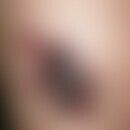DefinitionThis section has been translated automatically.
Coined by O. Raab in 1900, this is a form of photochemotherapy in which a photosensitizer (e.g., 5-aminolevulinic acid, porphyrin derivatives) reacts with visible light to produce cyto- or tissue-toxic products. The basic prerequisite for this reaction is the presence of oxygen. Redox processes and radical chain reactions produce reactive singlet oxygen, which reacts cytotoxically and can destroy tissue structures as well as amino acids, nucleic acids and fatty acids. The method exploits the affinity of certain porphyrin derivatives on tumor cells. Tumor cells, as well as macrophages, take up LDL-bound photosensitizers by endocytosis. Subsequent irradiation with polychromatic light sources leads to the destruction of the cells while sparing the surrounding tissue. Irradiation doses range from 25 to 300 J/cm².
see also antimicrobial photodynamic therapy, aPDT, PACT
IndicationThis section has been translated automatically.
According to the European Dermatology Forum guidelines on topical photodynamic therapy, approval exists in Europe for the following indications:
- Actinic keratoses
- squamous cell carcinoma in situ, M. Bowen
- superficial basal cell carcinoma
- nodular basal cell carcinoma
- Field carcinoma
Recommendation grade A for: actinic keratoses, squamous cell carcinoma in situ, M. Bowen, superficial basal cell carcinoma, nodular basal cell carcinoma and photorejuvination.
Not approved in Europe according to the European Dermatology Forum guidelines on topical photodynamic therapy, but recommendation grade B for photodynamic therapy exists for the treatment of nonmelanocytic skin carcinomas in organ transplant patients, acne, refractory genital and plantar warts, skin leishmaniasis , and onychomycosis
Also not approved, but still recommendation grade C is given by the European Dermatological Forum in the guidelines for superficial fungal infections, deep cutaneous tinea and hypertrophic scars and keloids.
For cutaneous T - cell lymphoma, the European Dermatology Forum recommends the use of topical PDT only for localized disease with recommendation grade C.
PDT with porphyrin derivatives: Also as second-line therapy in patients with advanced squamous cell carcinoma of the head or neck (after failure of previous therapies and non-feasibility of radiotherapy), excision and systemic chemotherapy.
- Preliminary results requiring further clinical confirmation have been reported in the following conditions:
You might also be interested in
ImplementationThis section has been translated automatically.
For actinic keratoses, one session, for basal cell carcinomas two (or more) sessions at an interval of one week: first, removal of scales and crusts on the lesion to be treated.
Application of the photosensitizing ointment (1 mm thick) by spatula on the lesion to be treated and overlapping 1 cm on the surrounding clinically healthy skin. Occluding and light-tight dressing. Therapy time over 3 hours if the methyl ester of aminolevulinic acid is applied (commercial preparation Metvix); over 6 hours if ALA is administered magistrally (usually 20%). Subsequently, irradiation (e.g. with red light, wavelength 570-670 nm in a dose of 75 J/cm²).
Undesirable effectsThis section has been translated automatically.
ContraindicationThis section has been translated automatically.
PreparationsThis section has been translated automatically.
- Photosensitizers: E.g. Metvix® (methyl aminolevulinate; Galderma Laboratorium GmbH, Düsseldorf) 160 mg/g cream, this cream is approved as a finished preparation, or e.g. Ameluz® (5-aminolevulinate; Biofrontera AG, Leverkusen) 78 mg/g gel also approved as a finished preparation.
- As an alternative to the cream base, a patch containing the active ingredient, Alacare® (5-aminolevulinate; photonamic GmbH & Co.KG, Reinbek) with 8 mg active ingredient per 4 cm² can be used on the face and on hairless areas of the scalp.
- Lamps: E.g. Aktilite (wavelength 630 nm especially when using Metvix); alternatively: BF-RhodoLEDZ. Wavelength 635 nm, or e.g. Hydrosun.
Note(s)This section has been translated automatically.
The treatment can only be performed by medical colleagues who have acquired sufficient experience in this therapy. Since these are so-called blind therapy procedures, histological clarification before the start of treatment, as well as a close clinical follow-up, is absolutely necessary!
The photodynamic therapy of actinic keratoses can also be performed as photodynamic daylight therapy.
LiteratureThis section has been translated automatically.
- Bickers R (1995) Photodynamic therapy. Z Hautkr 70: 328-331
- Braathen L et al (2007) Guidelines on the use of photodynamic therapy (PDT) for the non-melanoma skin cancer - an international consensus. J Am Dermatol 56: 125-143.
- Cairduff F et al (1994) Superficial photodynamic therapy with 5-aminolevulinic acid for superficial primary and secondary skin cancer. Br J Cancer 69: 605-608
- Cather J, Menter A (2002) Novel therapies for psoriasis. Am J Clin Dermatol 3: 159-173.
- Fritsch C, Ruzicka Th (2003) Fluorescence diagnosis and photodynamic therapy of skin diseases. Atlas and handbook. Springer, Heidelberg Berlin
- Gniazdowska B et al (2007) Allergic contact dermatitis from delta-aminolevulinic acid used for phtodynamic therapy. Contact Dermatitis 38: 348-349
- Hopper C (2000) Photodynamic therapy: a clinical reality in the treatment of cancer. Lancet Oncol 1: 212-219
- Landthaler M et al (1993) Photodynamic therapy of tumors of the skin. Dermatologist 44: 69-74
- Leman J et al (2002) Topical 5-ALA photodynamic therapy for the treatment of cutaneous T-cell lymphoma. Clin Exp Dermatol 27: 516-518.
- Pariser DM et al (2003) Photodynamic therapy with topical methyl aminolevulinate for actinic keratosis: results of a prospective randomized multicenter trial. J Am Acad Dermatol 48: 227-232.
- Raab O (1900) On the effect of fluorescent substances on infusoria. Z Biol 19: 524-564
- Szeimies RM et al (1994) Topical photodynamic therapy in the treatment of superficial skin tumors. Dermatologist 46: 315-318
- Szeimies RM et al (2002) Photodynamic therapy using topical methyl 5-aminolevulinate compared with cryotherapy for actinic keratosis: A prospective, randomized study. J Am Acad Dermatol 47: 258-262.
- Valenta C et al (2005) Skin permeation and stability studies of 5-aminolevulinic acid in a new gel and patch formulation. J Contr Rel 107: 495-501
Morton CA et al (2020) European Dermatology Forum guidelines on topical photodynamic therapy 2019 Part 2: emerging indications - field cancerization, photorejuvenation and inflammatory/infective dermatoses. JEADV 34: 17-29










